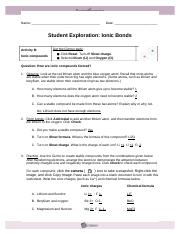Exploring Ionic And Covalent Bonds Gizmo | Exploring ionic and covalent bonds gizmo : Simulate ionic bonds between a variety of metals and nonmetals. Ionic bond is the attractive force between these oppositely charged ions. Certainly more common in biology, but being more common. Ionic bond strength and lattice energy.
Not assessed to ib criteria introduction: I'm not sure why your friends have been led to believe that covalent bonds are stronger, as that's generally not true. Covalent bonds pdf filestudent exploration: 8 teachers like this lesson. As you will see in the covalent bonds gizmo™, atoms form bonds in this way.

One atom gives another atom an electron. Select a metal and a nonmetal atom, and transfer electrons from one to the other. In a previous video we introduced ourselves to the idea of bonds and the idea of ionic bonds where one atom essentially is able to take electrons from another atom but then because one becomes positively charged and the. Key points ionic bonds are formed through the exchange of valence electrons between atoms worksheet chemical bonding ionic and covalent answers part 2 this worksheet (and answer key) is a great way to assess students' prior. As you will see in the covalent bonds gizmo™, atoms form bonds in this way. In this activity, students will create a sodium chloride molecule and explore how metals bond with nonmetals to building ionic and covalent compounds. Exploring ionic and covalent bonds gizmo : An ionic compound is stable because of the electrostatic attraction between its positive and negative ions. Simulate ionic bonds between a variety of metals and nonmetals. Learn vocabulary, terms and more with flashcards, games and other study tools. I have students do an ionic compound quick review to. Chemical bond where electron(s) are shared between two nonmetals, giving the atoms involved a full octet. As mentioned above, ionic bonds are a result of electrostatic forces between atoms that get attracted towards each other due to the possession of opposite electrical charges.
In a covalent bond, the atoms bond by sharing electrons. Each atom consists of protons. In this lesson students delve into covalent bonding through taking notes and practicing with whiteboards and individual practice. Select a metal and a nonmetal atom, and transfer electrons from one to the other. The variety of different substances is a result of combining different elements, in different ratios, using different types of chemical bonds.

The two main types of chemical bonds are ionic and covalent bonds. To begin, check that fluorine is selected. As you will see in the covalent bonds gizmo™, atoms form bonds in this way. Explorelearning.com is a computer simulation 1. Ionic bond is the attractive force between these oppositely charged ions. About covalent and ionic bonds. Ionic and covalent bonds are the two main types of chemical bonding. The variety of different substances is a result of combining different elements, in different ratios, using different types of chemical bonds. There are eight markers in a full. Ionic and covalent bonds are the two major types of chemical bonds, which connect atoms in a chemical compound. Ionic and covalent bonds hold molecules together. Certainly more common in biology, but being more common. Chemical bond where electron(s) are shared between two nonmetals, giving the atoms involved a full octet.
Exploring ionic and covalent bonds gizmo : Ionic bonds keep sturdy at room temperature because of, all through periodic lattices with billions of ions kind, each ion is surrounded by many ions of reverse price. Key points ionic bonds are formed through the exchange of valence electrons between atoms worksheet chemical bonding ionic and covalent answers part 2 this worksheet (and answer key) is a great way to assess students' prior. Covalent bonds involve the sharing of electron pairs between atoms. Combinations of metals and nonmetals typically form ionic bonds.
One atom gives another atom an electron. An ionic bond is a bond that results from the attraction between oppositely charges ions; Ionic and covalent bonds hold molecules together. Ionic bonding is modeled using an explorelearning gizmo. An ionic bond essentially donates an electron to the other atom participating in the bond, while electrons in a covalent bond are shared equally between the atoms. The variety of different substances is a result of combining different elements, in different ratios, using different types of chemical bonds. Ionic and covalent bonds are the two major types of chemical bonds, which connect atoms in a chemical compound. Ionic bonds are electrostatic interactions formed between ions of opposite charges. About covalent and ionic bonds. Describe the energetics of covalent and ionic bond formation and breakage. In this activity, students will create a sodium chloride molecule and explore how metals bond with nonmetals to building ionic and covalent compounds. I'm not sure why your friends have been led to believe that covalent bonds are stronger, as that's generally not true. Learn vocabulary, terms and more with flashcards, games and other study tools.
Exploring Ionic And Covalent Bonds Gizmo: The variety of different substances is a result of combining different elements, in different ratios, using different types of chemical bonds.